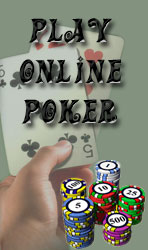Pokerwiner.com → Lessons of poker
THE REALITY OF BLUFFING
With this proviso, it must be repeated that from a theoretical point of view, bluffing is an extremely important aspect of poker.
As a deceptive weapon, it is at least as important as slow playing. Whereas slow playing suggests weakness when you have strength, bluffing announces strength when you are weak.
Recollect the Fundamental Theorem of Poker: Any time an opponent plays his hand incorrectly based on what you have, you have gained; and any time he plays his hand correctly based on what you have, you have lost. An opponent who knows you never bluff is much less likely to play his hand incorrectly. Any time you bet, he will know you are betting for value.
He will play only when he figures he has a better for value. He will play only when he figures he has a better hand than your or when he is getting sufficient pot odds to call with more cards to come. Bluffing, then, or the possibility that you might be poker bluffing, is another way of keeping your opponents guessing.
Your occasional bluffs disguise not just the hands with which you are in fact bluffing but also your legitimate hands, with which your opponents know you might be bluffing.
To see how important bluffing is, imagine that you are up against an opponent who on the last round bets $20 into a $100 pot. You are getting 6-to-1 from the pot if you call. However, you know you can only win, as is often the case, if your opponent is bluffing.
Let’s say know three opponent well. The first never bluffs in this spot, so you response to that player’s bet is easy: You fold with the full knowledge that you have not cost yourself any money.
The second opponent frequently bluffs. Once again your response is easy: You call, knowing you are going to win that last bet so often that calling must result in a long-run profit.
The third player is the problem. He bets in such a way that the poker odds are about 6-to-1 against his bluffing. In fact, he can tell you in advance that if he bets, he will be bluffing once in seven times.
Now you have a tough decision. You must choose between two equally upsetting alternatives. You are getting 6-to-1 from a pot you can win only if your opponent is bluffing, and the odds against your opponent’s bluffing are 6-to-1. If you fold, you know there’s a chance your opponent stole the pot from you; but if you call, you know that six times out of seven you are simply donating your money to your opponent.
Thus, a person who bluffs with approximately the right frequency and also, of course, in a random way is a much better poker player and will win much more money in the long run than a person who virtually never bluffs or a person who bluffs too much.
The person who never bluffs will never get much action. The person who always bluffs will get all the action he wants until he runs out of money.
But the person who bluffs correctly keeps his true holdings disguised and is constantly forcing his opponents into tough decisions, some of which are bound to be wrong.
OPTIMUM BLUFFING FREQUENCY
What is the right bluffing frequency? It is a frequency that makes it impossible for your opponents to know whether to call or fold. Mathematically, optimal bluffing strategy is to bluff in such a way that the chances against your bluffing are identical to the pot odds your opponent is getting. Thus, if, as in the example just given, an opponent is getting 6-to-1 from the pot, the chances against your bluffing should be 6-to-1. Then that opponent would break even on the last bet by calling every time an also by folding every time. If he called, he would lose $20 six times and win $120 once; if he folded, he would win nothing and lose nothing. Regardless of what your opponent does, you average winning an extra $100 every seven hands. However, mathematically optimal bluffing strategy isn’t necessarily the best strategy.
It is much better if you are able to judge when to try a bluff and when not to in order to show a bigger overall profit. To make sure we agree on what is meant by a bluff, we will define it as a bet or raise with a hand which you do not think is the best hand. Bluffing can be separated into a couple of different categories. There is bluffing when there are more cards to come and when there are no more cards to come. Secondly, within each of these categories, there is intuitive bluffing, which is the subject of this chapter, and mathematical bluffing, which will be discussed in the next chapter.



